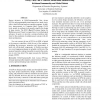Free Online Productivity Tools
i2Speak
i2Symbol
i2OCR
iTex2Img
iWeb2Print
iWeb2Shot
i2Type
iPdf2Split
iPdf2Merge
i2Bopomofo
i2Arabic
i2Style
i2Image
i2PDF
iLatex2Rtf
Sci2ools
FPGA
1995
ACM
1995
ACM
The Design of RPM: An FPGA-based Multiprocessor Emulator
Recent advances in Field-Programmable Gate Arrays (FPGA) and programmable interconnects have made it possible to build efficient hardware emulation engines. In addition, improvements in Computer-Aided Design (CAD) tools, mainly in synthesis tools, greatly simplify the design of large circuits. The RPM (Rapid Prototype Engine for Multiprocessors) Project leverages these two technological advances. Its goal is to develop a common hardware platform for the emulation of multiprocessor systems with different architectures. For cost reasons, the use of FPGAs in RPM is limited to the memory controllers, while the rest of the emulator, including the processors, memories and interconnect, is built with off-the-shelf components. A flexible non-intrusive event logging mechanism is included at all levels of the memory hierarchy, making it possible to monitor the emulation in very fine detail. This paper presents the hardware design of RPM.
Common Hardware Platform | Efficient Hardware Emulation | Field-programmable Gate Arrays | FPGA | FPGA 1995 |
| Added | 26 Aug 2010 |
| Updated | 26 Aug 2010 |
| Type | Conference |
| Year | 1995 |
| Where | FPGA |
| Authors | Koray Öner, Luiz André Barroso, Sasan Iman, Jaeheon Jeong, Krishnan Ramamurthy, Michel Dubois |
Comments (0)

